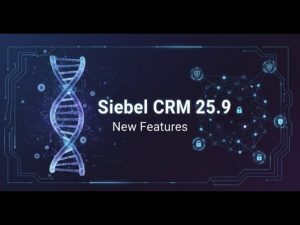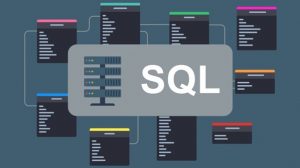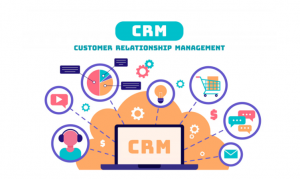

In the ever-evolving world of enterprise CRM, staying on the innovative means more than just minor patches — it means leveraging new capabilities that drive productivity, stability, and innovation. With the release of Siebel CRM 25.9, Oracle continues its pace of incremental updates, bringing enhancements across multiple domains: performance, extensibility, user experience, integration, and more.
In this guide, we’ll take a deep dive into what’s new or expected in Siebel CRM 25.9 — exploring feature highlights, architectural implications, upgrade advice, and how you can start preparing your organization for adoption.

Why 25.9 Matters: The Bigger Picture
Before we zoom into individual features, it helps to see where 25.9 fits in the broader trajectory of Siebel’s roadmap and strategy:
Continuous updates model: Oracle now issues more frequent, modular updates instead of monolithic version jumps. This allows incremental enhancement and faster delivery of bug fixes or feature improvements.
Convergence toward cloud & container readiness: Over recent updates especially 25.6 onward, Siebel has strengthened its support for containerized deployments, observability, cloud integration (OCI, Kafka, etc.). 25.9 is expected to continue that trend.
AI and automation growth: The foundation laid by earlier versions for integrating AI/ML (sentiment analysis, generative summarization, speech-to-text, etc.) is likely to be extended further.
Upgrade and customization resilience: As customizations proliferate in enterprise deployments, Oracle is gradually refining the upgrade tooling, workspace/migration framework, rollback safety, and diagnostics to reduce upgrade risk.
With this strategic context in mind, let’s look at key functional and technical enhancements that are—or likely will be—part of 25.9.
Key Features & Enhancements in Siebel CRM 25.9
Below is a breakdown of the most compelling updates, grouped by domain.
In recent updates (e.g. 25.6), Oracle introduced Coherence-based enterprise cache support. 25.9 may further refine cache invalidation, eviction policies, or multi-node synchronization to reduce latency and boost throughput.
Expect enhancements in SQL plan stability, better indexing strategies, or adjustments to default DB parameters for major RDBMS platforms. Also, more diagnostic instrumentation (e.g. extended tracing, heat maps) may be built in to help pinpoint bottlenecks.

As Siebel’s containerization stack matures, 25.9 could bring better support for orchestration (Kubernetes, Helm charts), health checks, auto-scaling behaviours, and container upgrade flows.
Extending metrics, logs, and tracing capabilities (e.g. OpenTelemetry or native integration) to give deeper insight into performance patterns and system health, especially in production environments.
Recent updates have introduced the Redwood styling and improvements to Task-based UI. 25.9 is likely to bring more consistency in styling, better responsiveness for mobile layouts, and smoother UI transitions.
Features like improved keyboard navigation, ARIA labelling, contrast adjustments, and screen-reader support may be enhanced to ensure compliance with accessibility standards.
Smarter dashboards with dynamic layouts or recommendations (e.g. “most used tiles”) may become more configurable by users or admins.
Reducing initial page load times by lazy-loading sections, minimizing DOM complexity, or caching UI components to speed up navigation.
Enhancements in REST API, web hooks, inbound/outbound interface stability and performance, pagination, error handling, and bulk operations may be included.
Support for streaming integrations (e.g. with Kafka or other message brokers), event publication/subscription enhancements, and better payload flexibility. Earlier updates have introduced support for Kafka integration and improved event payload structures.
More SDK enhancements, scriptable extension points, plugin hooks or version-safe APIs to minimize breakage in custom layers.
Improvements in low- or no-code integration patterns (mapping tools, transformation support, configuration-driven services) that reduce the need for hand-coded glue.

One of the most compelling domains in modern CRM is the infusion of AI/ML capabilities to streamline workflows, surface insights, and reduce manual burden. In 25.9, enhancements may include:
Building upon prior releases, 25.9 could expand the contexts where AI summarization, drafting, or content generation is used — e.g. automated responses, knowledge-based generation, or email drafting. Previous releases already introduced summarization and sentiment analysis.
Higher accuracy, support for additional languages, deeper context understanding, and aggregation across interaction threads.
Based on usage patterns or predictive scoring, the system might suggest next-best actions, auto-route tasks, or trigger workflows automatically.
Agents that detect anomalies in data inputs (typos, missing fields, inconsistent values) and prompt users or auto-correct based on learned rules.
Broader language support, transcription accuracy improvements, and conversational agent capabilities tied directly to Siebel workflows.
Enhanced migration tools (e.g. incremental delta handling, safer merges, conflict detection) so that upgrades from prior versions are smoother. Improvement of rollback paths (workspace versioning, repository rollback) is crucial in real-world enterprise settings.
Augmented dashboards or consoles for root-cause analysis (tracing failures across UI, business logic, integration), possibly with guided remediation.
Incremental updates that can be applied with minimal downtime, or orchestration frameworks that help coordinate activity across clustered environments.
Tools to detect deviations in configuration between environments (dev/test/prod), and suggestions to reconcile them.
Enhanced encryption support, stricter authentication/authorization controls, audit-logging improvements, PII masking, and compliance with evolving data privacy rules.

Of course, not every update is about flashy new features — many of the gains in 25.9 will come via:

Upgrade Considerations & Best Practices
When planning a migration to Siebel CRM 25.9, consider the following best practices:
Wait for Oracle’s formal 25.9 documentation; ensure your database, OS, and stack versions are compatible.
Run your critical custom flows, integrations, and scripts in a non-production environment to catch regressions early.
Identify which customizations, third-party add-ons or integrations might break (UI, back-end, scripts). Assess where APIs have changed.
Use Siebel’s workspace or migration application to manage versioning, delta deployment, and rollback strategies.
Ensure you have a valid fallback plan (e.g. snapshot, database backup, previous repository state) in case post-upgrade issues arise.
Capture key performance metrics pre-upgrade (response times, throughput, resource usage) so you can measure the impact of 25.9 post-launch.
Inform stakeholders, train users on new UI changes or feature shifts, and prepare support teams for anticipated issues.
If you operate in modules/domains, roll out the update in phases rather than a big bang to reduce risk.
After rollout, closely monitor logs, user experience, error rates — and be ready to iterate or patch quickly.
What to Watch Out For (Risks & Challenges)

Looking Ahead: What 25.9 Signals for Siebel’s Future
By examining 25.9 updates through the lens of past trends and incremental advancements, we can infer a few trajectories:
As AI becomes less of an add-on and more intrinsic, we may see predictive workflows, natural language interaction, and deeper context awareness built directly into Siebel.
Later versions might assume a microservices or container-first deployment model, with “on-premise” becoming a special case.
More plug-in architecture, version-safe APIs, and decoupled layers may make custom enhancements easier and less brittle.
A more integrated “single pane of glass” view of UI, backend, integration flows, and business logic, aiding both developers and administrators.
The upgrade friction will continue to shrink as Oracle enhances tooling for change capture, drift detection, and automated conflict resolution.

Wrapping Up
The Siebel CRM 25.9 update promises to be more than just a patch — it represents Oracle’s continued drive toward a more modern, performance-oriented, extensible, and intelligent CRM ecosystem. While many of the headline improvements will become clearer once the official release notes are available, the anticipated patterns—ranging from enhanced UI design and integration maturity to AI-driven automation and upgrade resilience—underscore the platform’s steady evolution.
For organizations preparing to adopt Siebel CRM 25.9, it’s crucial to approach the transition with careful planning around testing, version control, and stakeholder readiness. With the right strategy, this update can unlock tangible gains in stability, agility, and overall user productivity.
At BriskWinIT Solutions, we specialize in end-to-end Oracle Siebel CRM services—from implementation and upgrades to performance optimization and ongoing support. Our team ensures your Siebel environment stays future-ready, seamlessly aligned with Oracle’s latest innovations like version 25.9. If you’re planning your next Siebel upgrade, partner with BriskWinIT Solutions to make the transition smooth, efficient, and value-driven.
Frequently Asked Questions (FAQ)
Siebel CRM 25.9 is the latest update in Oracle’s continuous innovation model for Siebel. It introduces performance improvements, UI enhancements, stronger integration capabilities, and extended AI-driven functionalities. This update helps organizations modernize their CRM infrastructure while improving agility, usability, and long-term scalability.
Oracle typically follows a quarterly update cycle (e.g., 25.6, 25.8, 25.9, etc.), delivering incremental innovations and fixes instead of large, disruptive upgrades. This approach helps organizations adopt improvements faster and stay in sync with evolving technology trends.
Some of the key highlights include:
These collectively make Siebel 25.9 more efficient, secure, and intelligent than previous versions.
No, Oracle’s update model allows for incremental upgrades instead of full reinstallations. However, a proper impact assessment and compatibility review should be performed before applying the update. Working with an experienced Siebel service provider like BriskWinIT Solutions ensures your upgrade is smooth and risk-free.
In most cases, core customizations remain compatible, but some older scripts, UI tweaks, or integrations might require adjustments. It’s strongly recommended to test in a sandbox environment and validate all business-critical custom workflows before rolling out the update organization-wide.
Siebel 25.9 continues to expand on Oracle’s AI integration roadmap with:
These features make customer engagement and decision-making more intelligent and proactive.
Oracle has refined REST APIs, expanded event-driven integration via Kafka, and improved declarative integration tools. These updates allow Siebel to connect more seamlessly with ERP, analytics, and cloud-native systems—supporting modern, data-driven business ecosystems.
Before upgrading:
Partnering with experts like BriskWinIT Solutions helps ensure all these steps are executed efficiently and securely.
Yes. Siebel CRM has been evolving toward cloud-readiness through containerization and orchestration support. Version 25.9 further strengthens compatibility with Kubernetes, Docker, and Oracle Cloud Infrastructure (OCI), giving enterprises more flexibility in deployment and scalability.
BriskWinIT Solutions offers end-to-end Oracle Siebel CRM services, including:
With proven expertise in Oracle Siebel implementations, our team ensures your transition to 25.9 is smooth, secure, and strategically aligned with your business goals.
Join the Conversation
The Siebel CRM 25.9 update marks another exciting step forward in Oracle’s ongoing journey toward a smarter, more agile CRM experience. At BriskWinIT Solutions, we love hearing diverse perspectives from Siebel professionals, administrators, and business users alike. What are your thoughts on the Siebel 25.9 update? Which new features or improvements are you most excited about—or what challenges do you anticipate during the upgrade?
We invite you to share your insights, experiences, and suggestions in the comments or discussion thread below. Your perspective not only helps other Siebel users but also shapes how we explore future updates in our upcoming blogs.